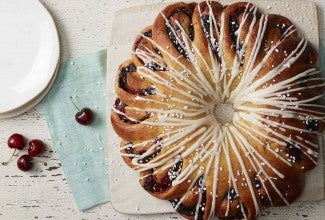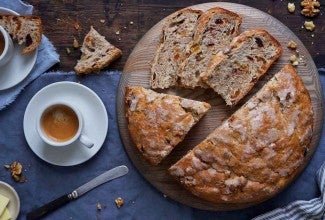-
To make the dough: Weigh your flours; or measure by gently spooning them into a cup, then sweeping off any excess.
-
In a medium bowl, combine the water, yeast, and cake flour. Add the all-purpose flour, butter, lard (or additional butter), confectioners’ sugar, and salt. Stir briefly, then use your hands to knead the mixture until it comes together in a smooth ball, about 5 minutes.
-
Divide the dough in half. Flatten each piece into a 6" square and wrap in plastic wrap. Refrigerate the dough for an hour; take this time to prepare the filling.
-
To make the filling: Finely chop two-thirds of the walnuts (216g, about 2 cups) in a food processor until ground (but not paste-like). Roughly chop the remaining walnuts.
-
In a large bowl, use a sturdy spoon to mix the ground and chopped walnuts with the breadcrumbs, cinnamon, and lemon zest.
-
In a small saucepan, combine the honey, granulated sugar, vegetable oil, water, and raisins. Bring to a boil. Remove from the heat and add to the nut mixture, stirring to combine. Spread the filling out on a baking sheet to cool.
-
Once the dough is chilled, remove it from the refrigerator and place it on a lightly floured work surface. Gently tap it with a rolling pin until it’s soft enough to roll.
-
Roll each piece of dough into a 10” x 12” rectangle with the short edge closest to you. Brush the edges with water and fold over 1/2” of dough on each side and on the bottom short edge closest to you.
-
Place half the filling on each piece of dough and spread evenly all the way to the folded edges, leaving about 1” without filling on the top (the short side farthest from you).
-
Starting from the short side closest to you, roll the dough into a cylinder and place it on a parchment-lined baking sheet, seam side down.
-
To glaze the beigli: Using a fork, gently beat the egg white in one bowl and the egg yolk in another bowl. Brush the outside of the beigli with the beaten egg yolk.
-
Loosely cover the beigli with greased plastic wrap and let them rest at warm room temperature (around 75°F is ideal) for about 40 minutes.
-
Brush the beigli with the beaten egg white then chill, uncovered, for 30 minutes. This step will help create the beigli's final crackled appearance.
-
While the beigli are chilling, preheat the oven to 350°F.
-
After the beigli have chilled, use a fork (or an ice pick if you have one) to make evenly spaced holes along the body and sides of the beigli. Push the fork deep into the dough; fifteen piercings will be adequate. This allows steam to escape as the beigli bake, helping maintain their cylindrical shape.
-
Bake the beigli for 20 minutes, then lower the oven temperature to 330°F and bake for another 35 to 40 minutes, or until the beigli are a beautiful mahogany color on the exterior.
-
Remove the beigli from the oven and let them cool completely before serving.
-
Store, well wrapped, at cool room temperature for a few days; freeze for longer storage.




















